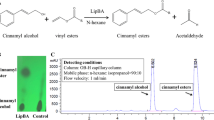Abstract
Transacylation of capsaicin with triolein using a commercial lipase gave olvanil in an 85% yield at 70 °C for 144 h. When olive oil was employed, the major product was olvanil (62%). Safflower oil gave a mixture of olvanil (39%) and linoleoyl vanillylamide (32%). Perilla oil gave linolenoyl vanillylamide (13%). Myristic acid and its methyl ester could be used as an acyl donor, and myristoyl vanillylamide was obtained in 20–78% using several lipases.
Similar content being viewed by others
References
Buck SH, Burks TF (1986) The neuropharmacology of capsaicin: review of some recent observations. Pharmacol. Rev. 38: 179–226.
Campbell EA, Dray A, Perkins MN (1989) Comparison of capsaicin and olvanil as antinociceptive agents in vivo and in vitro. Br. J. Pharmacol. 98: 907.
Kobata K, Yoshikawa K, Kohashi M, Watanabe T (1996) Enzymatic synthesis of capsaicin analogs with liver acetone powder. Tetrahedron Lett. 37: 2789–2790.
Kobata K, Kawamura M, Toyoshima M, Tamura Y, Ogawa S, Watanabe T (1998a) Lipase-catalyzed synthesis of capsaicin analogs by amidation of vanillylamine with fatty acid derivatives. Biotechnol. Lett. 20: 451–453.
Kobata K, Toyoshima M, Kawamura M, Watanabe T (1998b) Lipase-catalyzed synthesis of capsaicin analogs using natural oils as an acyl donor. Biotechnol. Lett. 20: 781–783.
Sietsema WK, Berman EF, Farmer RW, Maddin CS (1988) The antinociceptive effect and pharmacokinetics of olvanil following oral and subcutaneous dosing in the mouse. Life Sci. 43: 1385–1391.
Suzuki T, Iwai K (1984) Constituents of red pepper species: chemistry, biochemistry, pharmacology, and food science of the pungent principle of Capsicum species. In: Brossi A, ed. The Alkaloids: Chemistry and Pharmacology, Vol. 23. Orlando: Academic Press, pp. 227–299.
Szolcsányi J (1982) Capsaicin type pungent agents producing pyrexia. In: Milton AS, ed. Handbook of Experimental Pharmacology, Vol. 60. Berlin: Springer-Verlag, pp. 437–478.
Watanabe T, Kawada T, Kato T, Harada T, Iwai K (1994) Effects of capsaicin analogs on adrenal catecholamine secretion in rats. Life Sci. 54: 369–374.
Zaks A, Klibanov AM (1985) Enzyme-catalyzed processes in organic solvents. Proc. Natl. Acad. Sci. 82: 3192–3196.
Author information
Authors and Affiliations
Rights and permissions
About this article
Cite this article
Kobata, K., Kobayashi, M., Tamura, Y. et al. Lipase-catalyzed synthesis of capsaicin analogs by transacylation of capsaicin with natural oils or fatty acid derivatives in n-hexane. Biotechnology Letters 21, 547–550 (1999). https://doi.org/10.1023/A:1005567923159
Issue Date:
DOI: https://doi.org/10.1023/A:1005567923159



